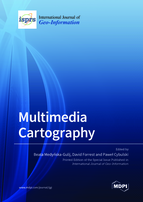Multimedia Cartography
A special issue of ISPRS International Journal of Geo-Information (ISSN 2220-9964).
Deadline for manuscript submissions: closed (30 December 2020) | Viewed by 59833
Special Issue Editors
Interests: cartographic design; multimedia cartography; geomedia; geomatic process; graphical means of expression; topographic works of art; mapping techniques; cultural heritage in virtual reality; reconstruction of historiogeographic space
Special Issues, Collections and Topics in MDPI journals
Interests: usability of GIS to design and produce sensible maps; design of topographic maps, especially at medium scales; design and usability of tourist and public transport mapping and information systems; geospatial data usability
Special Issues, Collections and Topics in MDPI journals
Interests: cartographic animation; eye tracking; geovisualization; multimedia cartography; visual perception
Special Issues, Collections and Topics in MDPI journals
Special Issue Information
Dear Colleagues,
Cartographic forms of expression connected with multimedia are technologies that interactively integrate image, video, audio, and animations. Multimedia cartography is a branch of cartography that focuses on the utilization of multimedia for the visualization and communication of data relating to space. The multidimensionality of spatial data is best presented using multimedia, for the user may more efficiently obtain and process information when he/she is forced to utilize multiple senses. The greater the interactivity between the data and the user, the greater the level of engagement with such multimedia.
This Special Issue focuses on the efficiency and attractiveness of the media for the visualization of spatial features and their information potential. We would like to invite you to submit your work exploring different media for cartography: film, animation, music, graphics, photos, sound, virtual and augmented reality, and others.
Contributions can address the following topics:
- Maps as the core of multimedia presentation
- Information potential of multimedia
- Medium efficiency and medium attractiveness for the visualization of spatial features
- Rules of map design for multimedia cartography
- Media for cartography: film, animation, music, graphics, photos, audio, virtual and augmented reality, and others
- Tools for designing specific cartographic multimedia products
- Statistic and topographic maps at medium scales
Prof. Dr. Beata Medynska-Gulij
Dr. David Forrest
Dr. Pawel Cybulski
Guest Editors
Manuscript Submission Information
Manuscripts should be submitted online at www.mdpi.com by registering and logging in to this website. Once you are registered, click here to go to the submission form. Manuscripts can be submitted until the deadline. All submissions that pass pre-check are peer-reviewed. Accepted papers will be published continuously in the journal (as soon as accepted) and will be listed together on the special issue website. Research articles, review articles as well as short communications are invited. For planned papers, a title and short abstract (about 100 words) can be sent to the Editorial Office for announcement on this website.
Submitted manuscripts should not have been published previously, nor be under consideration for publication elsewhere (except conference proceedings papers). All manuscripts are thoroughly refereed through a single-blind peer-review process. A guide for authors and other relevant information for submission of manuscripts is available on the Instructions for Authors page. ISPRS International Journal of Geo-Information is an international peer-reviewed open access monthly journal published by MDPI.
Please visit the Instructions for Authors page before submitting a manuscript. The Article Processing Charge (APC) for publication in this open access journal is 1700 CHF (Swiss Francs). Submitted papers should be well formatted and use good English. Authors may use MDPI's English editing service prior to publication or during author revisions.
Keywords
- Multimedia cartography
- Information potential of multimedia
- Map in film, animation
- Multimedia visualization of spatial features
- Medium efficiency
- Medium attractiveness
- Multimedia cartographic product








